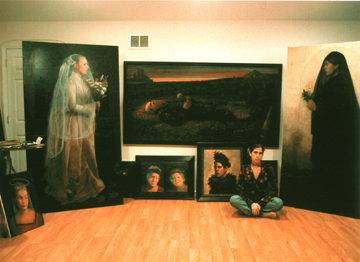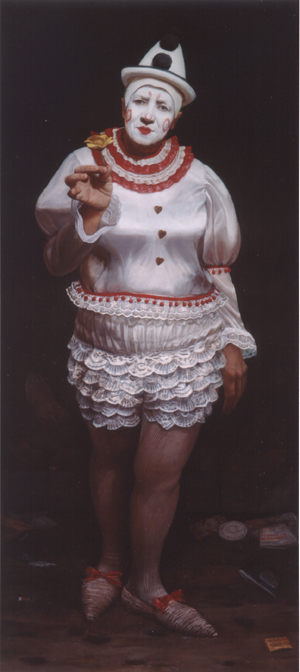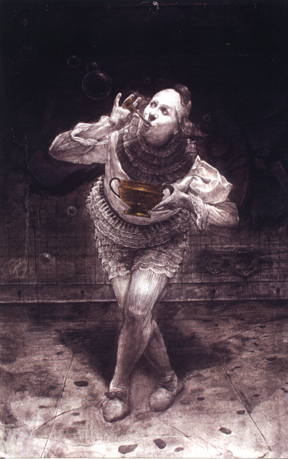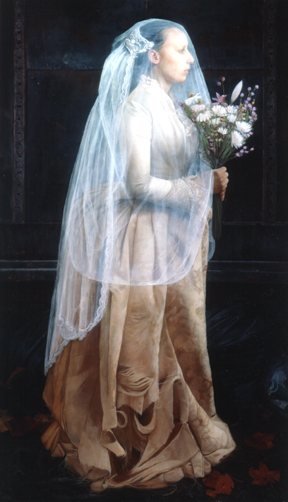Profile: Gabriela Gonzalez Dellosso
By RAYMOND J. STEINER
ART TIMES July 2004
 Gabriela Gonzalez Dellosso |
TWO PAINTINGS OF larger-than-life-size women — one in white, one in black — stand facing each other, dominating the space in Gabriela Gonzalez Dellosso’s studio.
The woman in white, in side view and tentatively titled "Bride" — looks straight ahead to our right. Her face, clearly visible under her white veil, reveals neither joy nor apprehension; if anything, her sternly held mouth denotes nothing other than resignation. Her hair is severely swept back in a tight bun. She holds a bridal bouquet in her right hand.
The woman in black — untitled — faces to our left. Her countenance, under her black veil, is equally visible to the viewer and, though her features are as firmly set as that of her counterpart, there is yet no sign of undue sadness in her mien. Her left hand holds a lighted candle and a sprig of what appears to be laurel leaves.
The contrast — or, perhaps ‘opposition’ is a better description in view of their respective stances — of the figures suggests at first glance a forthright contrariety, a deliberate statement of irreconcilable polar extremes, perhaps even a clue to the interviewer that such an antithesis must be sought in the artist herself. The commanding presence and placement of the women in the confined space of the studio almost demanded such interpretation. Were they not so placed to make a statement to the visitor?
 Gabriela Gonzalez Dellosso in her studio |
Almost automatically I listened for the disparity, the dichotomy of sensibilities that my initial impression expected to hear as the artist spoke of her work. Yet, as she set out a lunch on her terrace overlooking the Hudson — the skyline of midtown Manhattan starkly outlined across the way in the bright sunlight — I could detect no such vacillation in her demeanor, her voice (pleasantly modulated, decisive, confident), or her movements.
I had traveled some 100 miles to interview Dellosso for this profile and, almost immediately, she had put me at my ease, graciously inviting me to eat before we began the business of discussing her art. As we sat, a large birdcage of zebra finches twittered nearby, adding counterpoint to our conversation — the cage a smaller version of a much larger aviary that takes up a good portion of her living room. Since the cage on the terrace obviously held an "overflow," I asked my hostess, "Why so many?"
"I cannot stand to see them alone in a pet shop." She shrugged and smiled. "I feel I must take them home." Then, seriously, "They are reproducing quite quickly now." She glanced at me. "Would you like to take three of them home with you?" (I reluctantly demurred; my extensive traveling forbids pets.)
 Harlequin |
Lunch over, I lingered a few moments over the aviary in the living room, at the same time taking in the Carnivale "theme" which dominated the décor as Dellosso cleared away the remains of our meal. Flitting amongst more finches were a variety of exotic birds, all beautifully plumed, and most unknown to me. It took but a small stretch of imagination to see them as celebratory participants in their own festive carnival. Somehow, their caged activity did not disconcert me — these beautiful creatures were not so much prisoners as they were protected from the world outside. Masks, photographs of costumed people, a crumpled top hat lying atop the piano (her husband plays), and other Carnivale memorabilia tastefully arranged around the room denoted more than a passing fancy for the spirit of that great European Festival — and, indeed, as we settled in her studio some minutes later, the spirit of Carnivale was soon to be echoed in many of Dellosso’s major works.
Clowns — singly, in pairs, one, presumably deceased, lying on his back — all in full, colorful regalia, peer out through whitened faces at the viewer. Wide, rouged smiles do little to cover up saddened eyes, clenched jaws behind thin real-life lips, a downpour of rain — or even death. Again, I sensed the contrast that was so evident in the two white and black-clad women.
One of the clowns — a woman — faces us ("The Harlequin"). She wears a black, polka-dotted, conical cap set at a jaunty angle. Dressed almost all in white with a red accent of ruffles around her collar and waist, a pair of frilly pants barely covers her rather heavy legs. Red bows are affixed to her oversized, pointed shoes. She daintily holds a yellow rose in her right hand, stretching her arm towards the viewer. Though the flower is apparently proffered as a gift, her face, beneath the makeup, appears earnest, concerned, eyebrows drawn together as if she wishes to make some profound, philosophic point. Her odd stance both invites and rebuffs.
A second clown — "Victorian Bubble-Blower" — though her (his?) pose is more complex — his body bent forward, legs crossed, arms akimbo with his left hand holding a brass (gold?) two-handled vessel and his right a tiny brass (gold?) blowing pipe — appears less equivocal until we contemplate the significance of the ephemeral soap bubble being blown in our direction. A mixed message? Or just a happy rendition of the antics of a harmless clown?
 Victorian Bubble Blower |
Most unnerving — albeit eerily beautiful — is a prone clown ("Untitled") — asleep? dead? — not certain; his whitened face perhaps only make-up and not a death mask. He lies in a colorful bed of strewn confetti, a large, white, fully blown peony in his hands, which are crossed over his stomach. Some of the confetti adheres to his clothes. His oversized and absurd shoes pointing upward, his legs lying across a plastic piece of construction-type orange warning netting, his right foot only inches away from an orange and white rubber construction cone, beg explanation. Just beyond him, across a neglected field of nondescript weeds that contains another orange and white cone, we see the same colors echoed in the top section of a circus tent. Further yet in the distance is the skyline of Manhattan (the towers still intact) bathed in the suffused light of either an early morning or evening sky. Horizontal layers of stratiform clouds parallel the striped construction cones, the tent cover, and the black and white stripes of the clown’s knee-length stockings. A strong light from an unknown source (a spotlight?) highlights the body, most concentrated on the face, but bringing the entire clown out of the subdued, surrounding murk. Despite the obvious quote of Manet’s dead toreador, there is no indication that the French impressionist’s painting contains nearly as many ambiguities as does Dellosso’s prostrate clown.
Dellosso works large. In most cases one must step back to properly view her works. (The companion women as well as "The Harlequin" are all 80 inches high, the prone clown 80 inches wide.) It is, however, when we step close to note details that things do not seem so "black and white" — so easily pigeonholed into this or that category. Dellosso’s paintings, in fact, reflect the complexities and subtleties of her own nature. Gradually, it becomes clear that one draws hasty conclusions at one’s peril when attempting to describe either the artist or her art.
Of Ecuadorian and Cuban descent, Gabriel Gonzalez Dellosso possesses the raven tresses, proud bearing, penetrating eyes, and passionate nature (particularly evident when she speaks of her art) of her ancestors — all of which she captures in her several self-portraits (she herself is the model for the woman in black). Although composed in her demeanor and elegant in her manner and movements, one can easily detect hints of a fiery nature when she speaks about painting — a temperament that focuses her energies, steels her direction, suffers no distraction. I have little difficulty visualizing her in flamenco dress, forcefully stamping her feet to the music of a wildly strummed Spanish guitar. Even more so, in fact, when I consider her attraction to Carnivale — an event that both she and her husband have eagerly attended on more than one occasion in Venice, both of them gaily arrayed in elaborate handmade costumes that she and her mother devised.
 Bride |
With her instruction at the School of Visual Arts, at the Art Students League of New York, and at the National Academy of Fine Arts in New York now behind her, Dellosso is determined to strike out on her own, to follow her own vision, and to paint both the way and the subjects she chooses. With a long history of group and solo exhibitions and an enviable collection of medals, awards, and prizes, her confidence hardly seems misplaced. Already represented in several prestigious collections, there seems little doubt that her strength of character and no-nonsense approach will see her through.
Sheer strength and determination, however, is never enough to make the artist — and it is here that Dellosso’s quickened sense of color and form — the very essence of Carnivale — comes to the fore, especially as it is applied to both her sensibilities and to her handling of paint. Oils are nothing if not ‘sensual’ and those who recognize this quality in their pigments have traditionally made the most of their medium. A representational artist both in training and in predilection (she spent some years making a living as a book illustrator — and learning the principles of composition in the doing), Dellosso applies her paint with loving care, giving full play to color and texture, allowing for subtleties of nuance and direct statement, gently deferring to the inherent needs of her medium while never giving over such complete control that she loses the "her-ness" in her work.
It is, of course, this very "her-ness" — the Gabriela Gonzalez Dellosso element — that is at the very heart of her painting. Neither black nor white, she is both of the women facing each other — as well as the bubble-blowing, serious and dead clowns. Like herself, none of her paintings are simple statements. Look closely at "Bride." Her beautifully patterned bridal dress reveals a tattered bottom as our eyes travel downward from her face. Dead leaves lie at her feet and even some of the flowers in her bridal bouquet appear to be slightly wilting. The "Bride" is standing against a forbidding backdrop that might even suggest the walls of a dungeon.
Likewise, her counterpart — the lady in black — although she seems to be holding the symbols of hope and peace, stands in street detritus in front of an equally dismal background of a stark concrete wall. Even the "Harlequin" stands amidst discarded paper cups and cigarette packs against a darkened wall.
Carnivale is, of course, all about the mask. All about nothing or no one appearing as it or they actually are. Like Poe’s "The Mask of the Red Death," people live in a deceptive world of constant decay and immanent death. Desolation and annihilation lurk behind us, lie at our feet. And yet we paint our faces, strive for laughter, act the clown — all the while knowing that we, like the world, are simply too complex, too multi-layered, too ambiguous, to ever be lightly summed up.
And the painter — like the clown — can only blow ever-delicate bubbles — as deceptively transparent and exquisitely fragile as, ultimately, is the bubble-blower. But, if we look, take the time to look closely, we will not only be delighted and dazzled by the spectacle, but we may also come away with a deep lesson in morality and a better understanding of the human condition. And, for a painter to be able to give us that, is no small gift.
For further information about Gabriela Gonzalez Dellosso’s work, contact artsalime@hotmail.com
